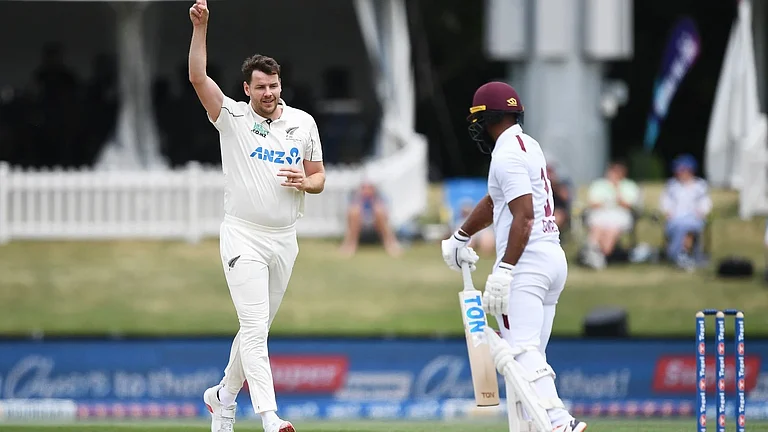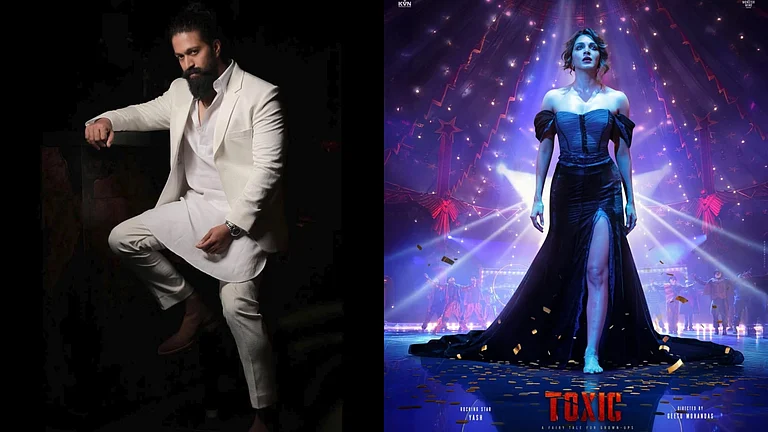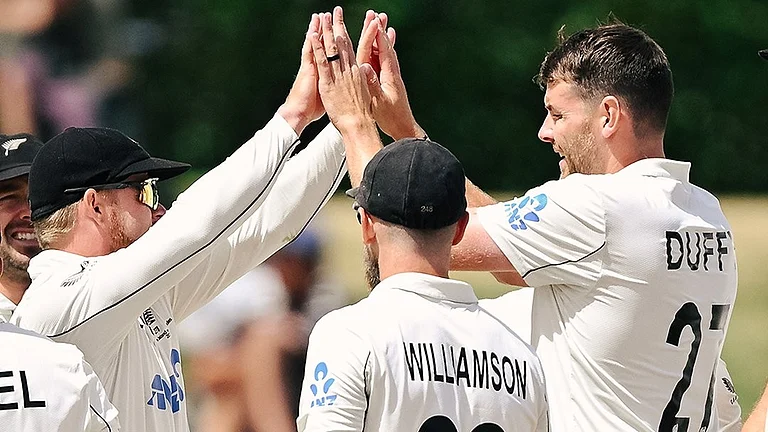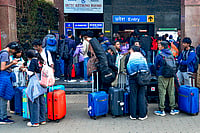Syed Salahuddin
- Born in Soibugh, in Budgam district in 1946; named Mohammed Yousuf Shah
- Graduated from SP College in Srinagar and did master’s in political science from the University of Kashmir in 1971
- Father of five sons and two daughters
- Joined Jamaat-e-Islami, a religio-political organisation
- Taught at a school and gave Friday sermons at a mosque in Srinagar
- Contested 1987 election as Muslim United Front (MUF) candidate, from Amirakadal constituency in Srinagar; lost to NC candidate
- Elections were said to be rigged; he and many of his supporters were jailed
- In 1990, after his release, he joined Hizbul Mujahideen and crossed over to Pakistan
- He took over as Hizbul chief in 1991
***
A few hours ahead of PM Narendra Modi’s June 26 meeting with US president Donald Trump, Hizbul Mujahideen chief Mohammed Yousuf Shah, aka Syed Salahuddin, issued a protest calendar for the Kashmir Valley, leaving many surprised. In the past three decades of insurgency, such calls for protest have usually come from separatist political groups. Since July 8, 2016—the day Hizbul commander Burhan Wani and two other Kashmiri militants were killed in an encounter with government forces at Kokernag, around 90 km south of Srinagar—the protest calls have been given by three pro-freedom leaders, Syed Ali Geelani, Mirwaiz Umer Farooq and Mohammed Yasin Malik. Over 90 lost their lives and 16,000 were injured during the long protests that ensued.
In a video message, Salahuddin—surely unaware of what was to happen in Washington later that day—announced that “hafta-e-shuhuda” (martyrdom week) would be observed on both sides of the Line of Control (LoC) to commemorate Burhan on his first “martyrdom” anniversary. He also declared a shutdown on two days: July 8, in Burhan’s memory, and July 13, for the 22 Kashmiris killed by the erstwhile ruler Maharaja Hari Singh’s forces during protests against his regime in 1931. Every year, on July 13, the state government and the separatists have been paying tributes to the 1931 martyrs. Many in the Valley see Salahuddin’s message as an attempt to replace the Hurriyat Conference, the separatist conglomerate—“and rightly so, to save the movement,” says lawyer and political observer Baber Qadri.
Soon after the protest calendar came news of the US State Department declaring Salahuddin a “specially designated global terrorist” (SDGT). “In September 2016, Salahuddin vowed to block any peaceful resolution to the Kashmir conflict, threatened to train more Kashmiri suicide bombers and vowed to turn the Kashmir Valley ‘into a graveyard for Indian forces’. Under Salahuddin’s tenure as a senior HM (Hizbul Mujahideen) leader, HM has claimed responsibility for several attacks, including the April 2014 explosives attack in Indian-administered Jammu and Kashmir, which injured 17 people,” read the State Department statement.
“I was shocked. Salahuddin is to us what Bhagat Singh and Subhas Chandra Bose are to India. The ‘global terrorist’ designation makes no sense as Salahuddin’s activities are confined to Kashmir,” says separatist leader Shabir Shah. “We have been urging the US to play its role in resolving Kashmir and by referring to ‘Indian-administered Jammu and Kashmir’ in the same statement, it has hinted that it indeed has a role in the conflict’s peaceful resolution. From my interactions with US diplomats and politicians, I know that the US sees Kashmir as a dispute—a nuclear flashpoint as the then President Bill Clinton described it—and we are hopeful that Kashmir will now be on the international radar like never before.”
Many in the separatist camp share Shah’s optimistic reading of the US statement. A senior leader, requesting anonymity, says the US has conceded just one point to India by designating Salahuddin a terrorist, “but left enough room open for future intervention by stating Jammu and Kashmir is Indian-administered and talking about peaceful resolution.”
Senior police officials in J&K, though, do not look forward to US involvement. They also admit that the “global terrorist” tag is just a diplomatic win for India that would make no difference to what the forces have to face every day on the ground. “It is diplomatic victory for India and that is it,” says a senior police officer who has handled counter-insurgency through most of his career. “But if you think you can translate this victory into anything positive in Kashmir, you are mistaken. Pakistan has been dealing with the Americans for long and you must see its double game in Afghanistan. Militancy and cross-border terrorism will continue in Kashmir in much the same way.”
According to the officer, Hizbul got rejuvenated after Burhan dropped the outfit’s veil of secrecy and used social media to galvanise public support and find recruits. He says a big worry now is whether the US move would push the militant organisation, which has always rejected the “global Islamist” ideology of terror groups such as ISIS and Al Qaida, towards maverick hardliners such as expelled Hizbul commander Zakir Musa, who recently called for establishing the Khilafat (Islamic Caliphate) and condemned the waving of Pakistan flags as anti-Islam.
Pointing out that Salahuddin has consistently been one of the most recognisable faces of Kashmiri militancy in the past three decades, political analysts Gowhar Geelani says, “The US decision will have an entirely symbolic impact, affecting the image of Kashmir militancy. Anyway, it is just one country that has done it, not the United Nations. What is significant is that the US state department has mentioned ‘Indian-administered Jammu and Kashmir’ and ‘peaceful resolution’, which goes against New Delhi’s position. So, even the diplomatic victory loses its sheen.”
A senior army official, who didn’t wish to be named, agrees the declaration will have no impact on the ground. “It would have been of some use if it could end militancy here. But it can’t,” he says. As Tariq Naqash, a political commentator based in Muzaffarabad in Pakistan-occupied Kashmir, argues, such a decision didn’t affect Jamaat-ud-Dawa (JuD), so it wouldn’t affect Hizbul either. “As long as these groups enjoy popular support, these announcements make little difference. Pakistan, which has otherwise been blindly following Washington, has also criticised this decision and reiterated its support to the just cause of Kashmiris.”
Formed in 1990, Hizbul is the largest militant organisation operating in J&K. Two years after the 1987 assembly polls, believed to have been widely rigged, a schoolteacher, Master Ahsan Dar, made two trips across the LoC. Then, on September 16, 1989, after he returned, a press statement was issued announcing Hizbul’s formation, with Dar as its first chief. Salahuddin replaced him in November 1991 and has been its “supreme commander” since.
Salahuddin is a native of Soibugh village in central Kashmir’s Budgam district. After graduating from the University of Kashmir, he joined Jamaat-e-Islami as a full-time member and taught at a Jamaat-run school, besides leading Friday prayers in a Srinagar mosque. He contested the 1987 polls from Amirakadal constituency for the Muslim United Front (MUF), a newly-formed amalgam of many social, religious and political organisations. It is believed there was large-scale fraud in the counting as Salahuddin, who was expected to win, lost to National Conference leader Ghulam Mohi-ud-din Shah by 4,289 votes. Salahuddin was arrested and put behind the bars. He joined Hizbul in 1990 after his release and crossed over to Pakistan. Known as Pir Sahab in Hizbul circles, he went to Khost in Afghanistan for training at an Al-Badr camp run by Hizb-e-Islami chief Gulbuddin Hekmatyar.
“If democratic exercises such as the 1987 election had been conducted fairly and voices of dissent respected, we wouldn’t have seen the terrible phases the state has been passing through,” CM Mehbooba Mufti told the assembly a few days ago. According to her, the muzzling of dissent forced many who wanted to join mainstream politics to choose otherwise. Salahuddin was one of those.
According to the then IGP A.M. Watali, the movement for an armed rebellion had started after Maqbool Bhat’s 1984 hanging in Delhi’s Tihar jail. Bhat, known among separatists as ‘Father of the Kashmiri Nation’, had founded the pro-azadi Jammu Kashmir Liberation Front (JKLF) and was accused in a case of murder of an intelligence official in the late 1960s. His hanging enraged and motivated a large number of Kashmiri youth. And in 1988, a year after the “rigged” election, they started crossing the LoC in droves to become part of the armed insurgency.
Over the years, Hizbul overtook JKLF as the most powerful militant organisation in Kashmir. While JKLF was disarmed and its militants came overground, Hizbul grew to a point where it had thousands of militants operating in the Valley. All along, Hizbul has maintained that Kashmir is not a border dispute or a territorial problem, but a political issue. According to its website, “Hizbul Mujahideen believes that the Indian leadership should recognise the ground realities, accept the internationally recognised Kashmir dispute as the source of all the troubles and demonstrate the political will to address it. Hizbul Mujahideen appeals the major powers of the world and other members of the international fraternity to use their good offices to convince India that use of force to curb a genuine movement for self-determination will be a self-destructive exercise. In case India sincerely creates congenial conditions and positive environment in the state, Hizbul will respond positively.”
Salahuddin’s announcement of an unilateral ceasefire in mid-2000 was in sync with this thinking, but the possibilities seemingly opened by it ended in a blame game. Now, that sounds like another era. While the US has designated Salahuddin as a “global terrorist”, police sources say his control over the 100-odd Hizbul members is slipping, with most operational decisions being taken by local commanders.
***
Before The Obit: The Hizbul Story
- 1990 Formed in 1990, Hizbul Mujahideen (‘Party of Holy Warriors’) favoured a merger with Pakistan. Master Ahsan Dar from Pattan, north Kashmir, was its first chief. On November 11, 1991, Syed Salahuddin became supreme commander of the outfit.
- 1991 The Tehreek-e-Jihad-e-Islami, led by Abdul Majeed Dar, merged with Hizbul
- 1993 Founder-member Maqbool Illahi and commander Shams-ul-Haq (pic) were killed in two different incidents in December. By 1993, Hizbul was the only active outfit, with a vast network of over 6,000 militants.
- 1994 Mast Gul, a foreign militant, crossed the LoC and entered Kashmir. From February 1995 he was in Charar-e-Sharief, organising his men for a prolonged confrontation.
- May 11, 1995 Most Hizbul cadres with Mast Gul managed to escape from the cordon laid by security forces
- September 19, 1996 The state government declared Hizbul an unlawful association and banned it under the J&K Criminal Law (Amendment) Act, 1983
- 1997 Chief commander Gazi Naseeb-ud-din was killed along with commanders Engineer Firdous Kirmani, Manzoor Khan and Abdul Majeed Wani
- 1998-99 Nearly 150 pro-Pakistan groups operated in the Valley, but Hizbul was perhaps the only one with a large network
- July 2000 Abdul Majeed Dar, Hizbul operational commander, announced unilateral ceasefire
- August 2000 The Union home secretary met four Hizbul commanders led by Riyaz Rasool. Fazal-haq-Qureshi, People’s Political Front chief and Hizbul-nominated mediator, was also present. The home secretary said the then PM A.B. Vajpayee and home minister L.K. Advani had given the go-ahead for the dialogue process.
- March 23, 2003 Unknown gunmen shot dead Abdul Majeed Dar at Sopore
- 2004 Ghulam Rasool Dar alias Gazi Naseeb-ud-din, operations commander, and finance chief Fayaz Ahmad killed by security forces
- 2008 Junaid-ul-Islam, Hizbul spokesman and face in Kashmir, arrested from Srinagar
- 2009 Muzaffar Ahmad Dar, chief commander for operations, arrested; Mohamed Sidiq Dar alias Saquib, Hizb second-in-command, killed
- 2011 State’s longest surviving militant leader Mushtaq Khan alias Mushtaq Jhangi killed
- July 8, 2016 Popular militant commander Burhan Wani was killed. Unlike other militants, Burhan started posting his pictures on social media. On his funeral, according to intelligence sources, over 2 lakh people participated.
By Naseer Ganai in Srinagar


























